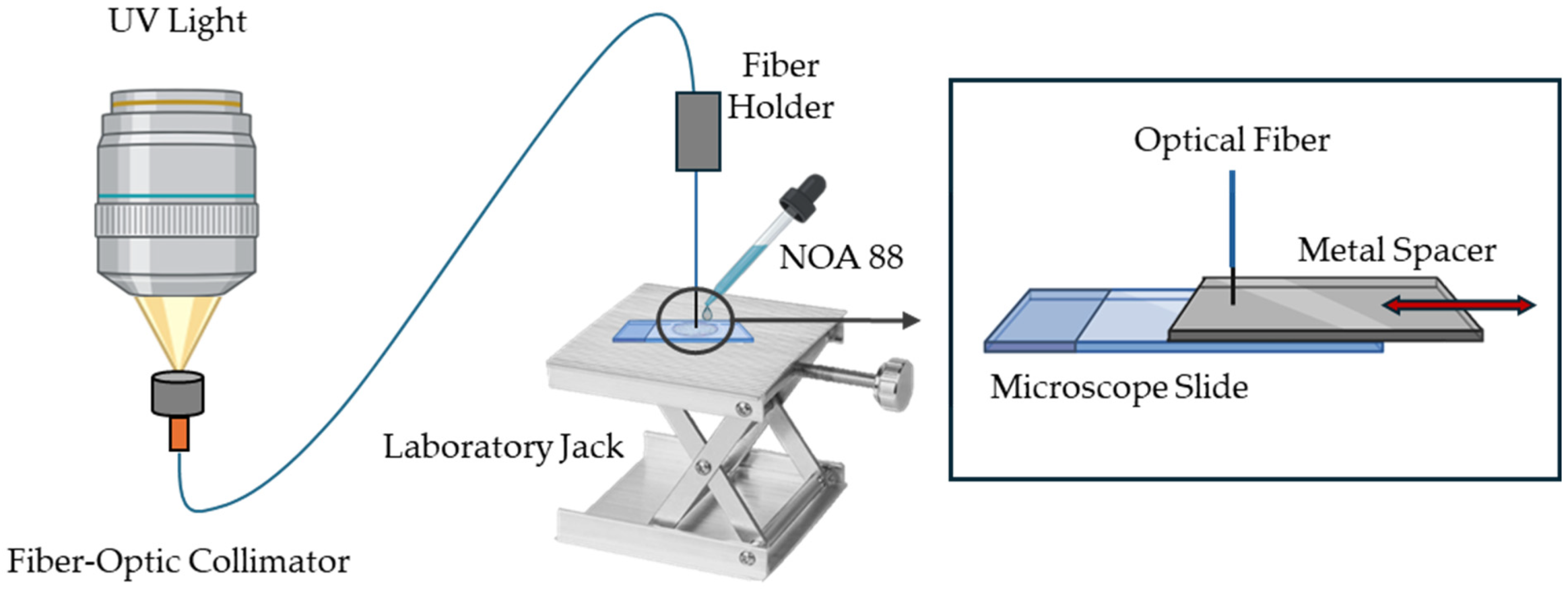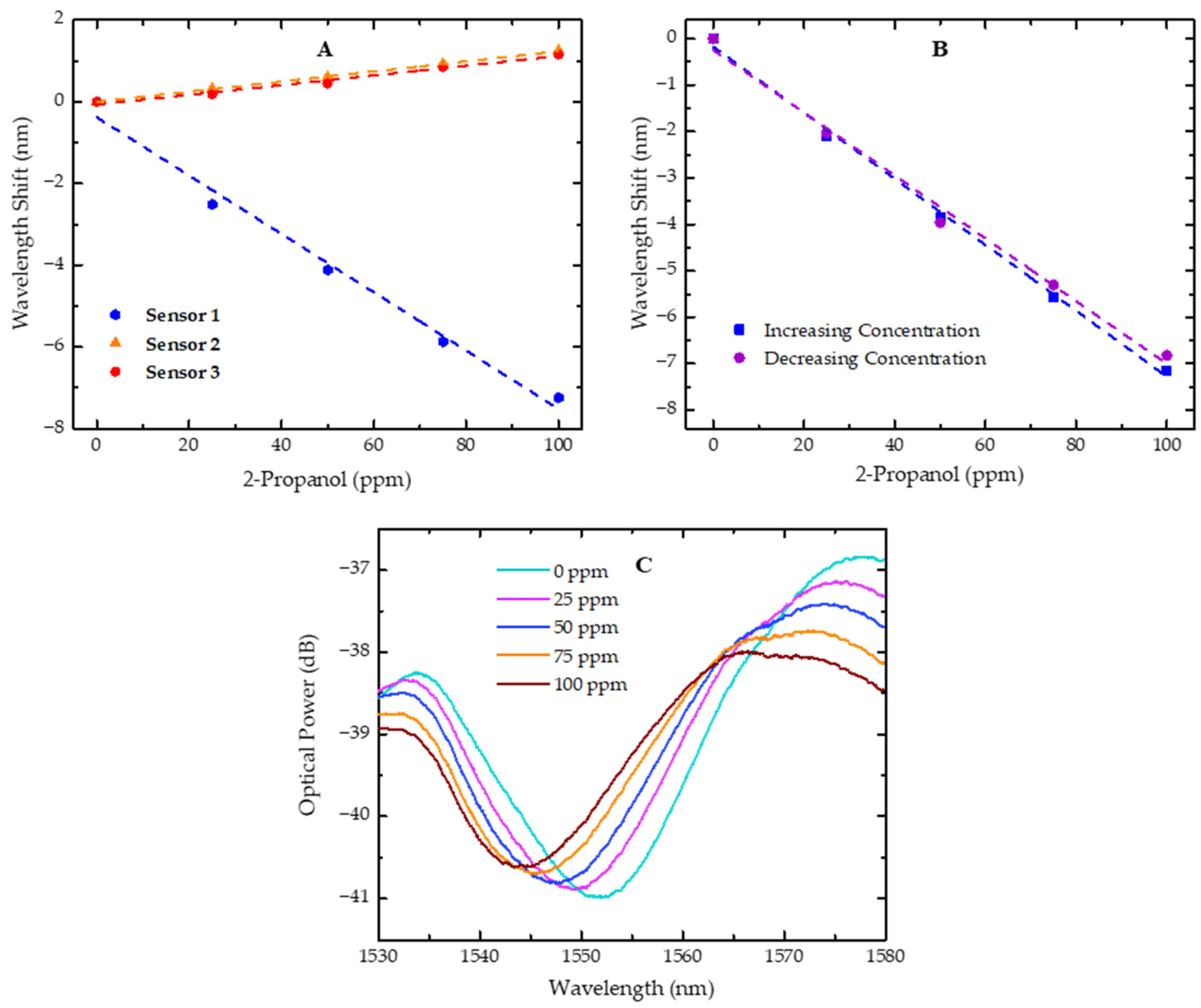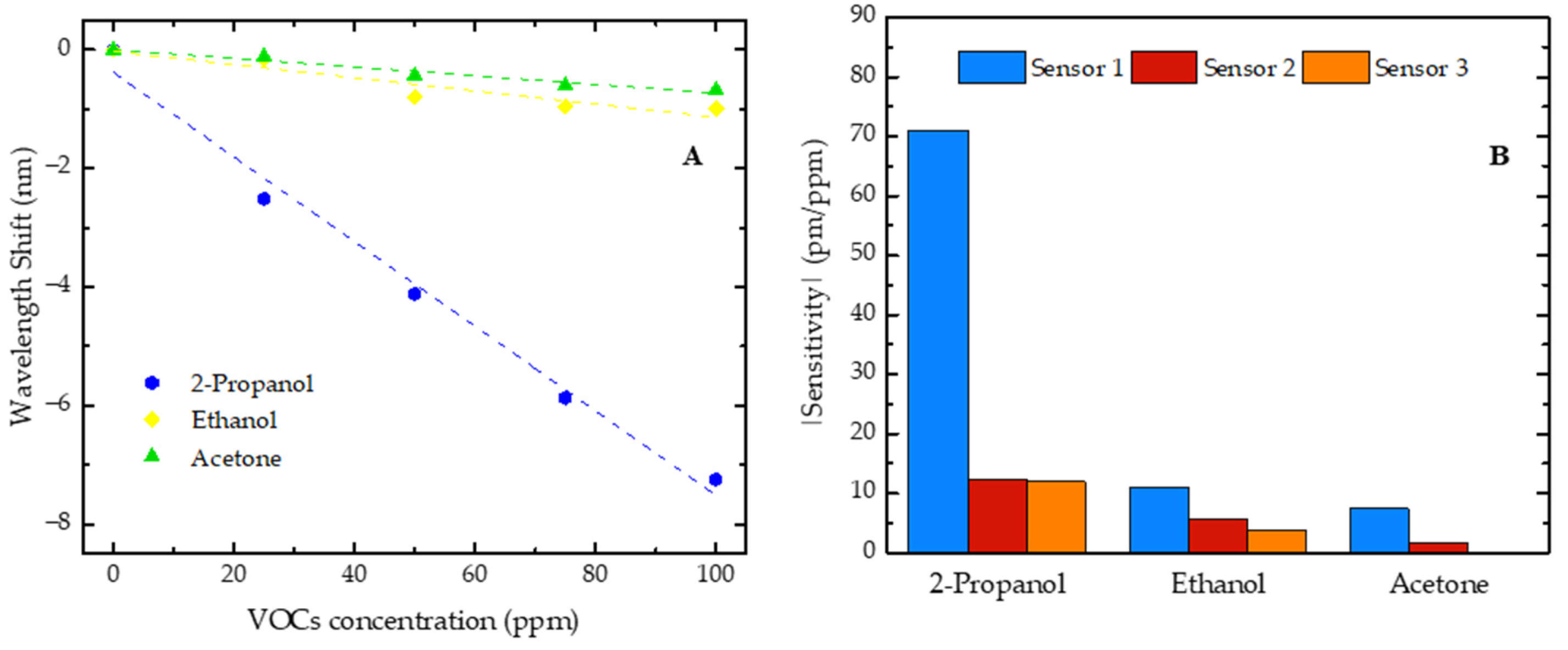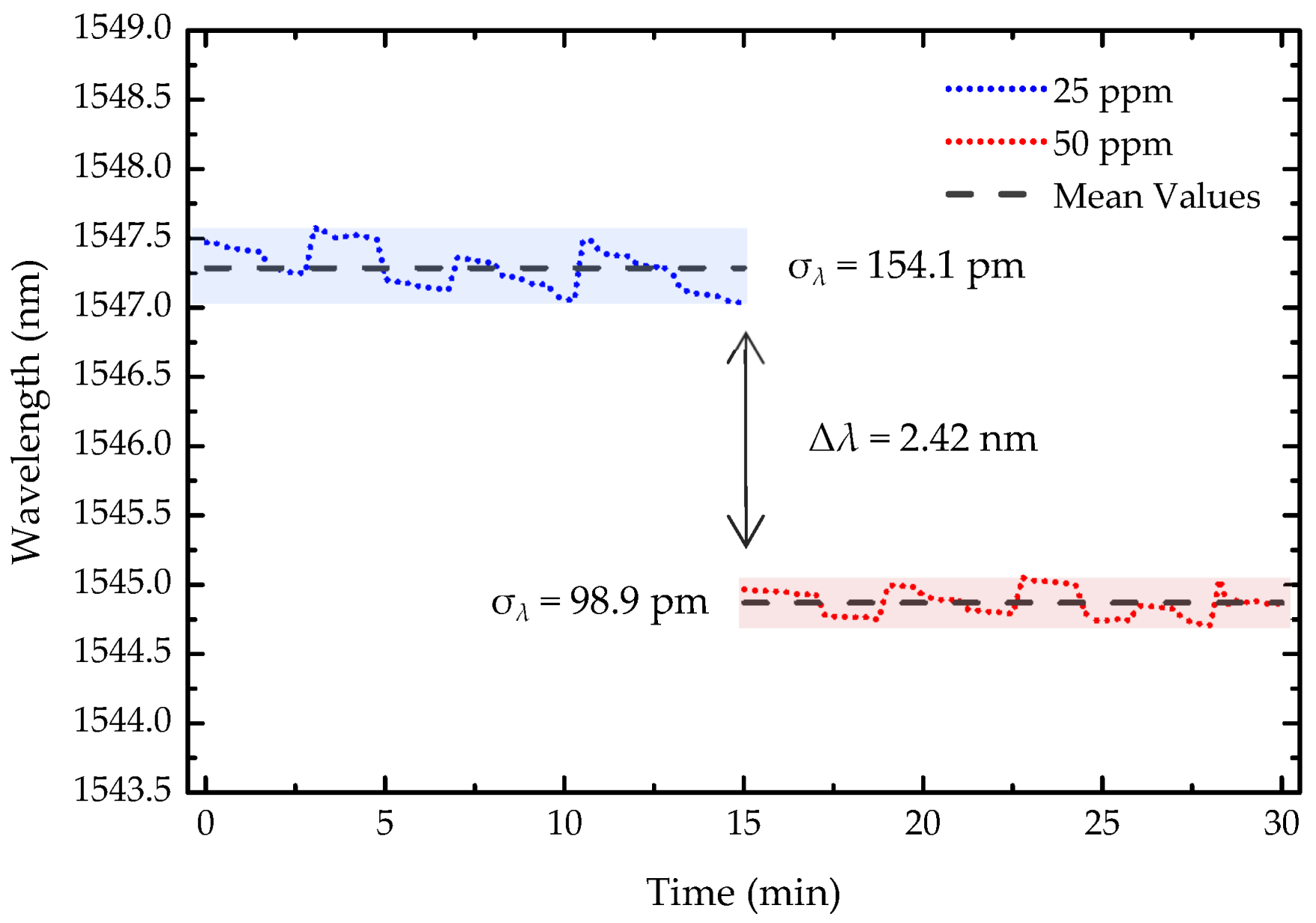A Novel Fiber-Optical Fabry–Perot Microtip Sensor for 2-Propanol
Abstract
1. Introduction
2. Sensing Principle and Fabry–Perot Microtip Manufacturing
2.1. Sensing Principle
2.2. Sensor Fabrication Process
3. Sensor Measurements and Characterization
4. Results and Discussion
4.1. Overall Characterization of the Fabricated Sensors
4.2. Performance of Sensors in 2-Propanol Detection
4.3. Cross-Sensitivity to Other VOCs (Ethanol and Acetone)
4.4. Performance Evaluation of the Sensor with the Highest Sensitivity
5. Conclusions
Author Contributions
Funding
Institutional Review Board Statement
Informed Consent Statement
Data Availability Statement
Conflicts of Interest
References
- Jalal, A.H.; Alam, F.; Roychoudhury, S.; Umasankar, Y.; Pala, N.; Bhansali, S. Prospects and Challenges of Volatile Organic Compound Sensors in Human Healthcare. ACS Sens. 2018, 3, 1246–1263. [Google Scholar] [CrossRef]
- Cumeras, R.; Correig, X. Volatile Organic Compound Analysis in Biomedical Diagnosis Applications, 1st ed.; CRC Press: Toronto, ON, Canada, 2018; ISBN 0429782438. [Google Scholar]
- Navaneethan, U.; Parsi, M.A.; Lourdusamy, D.; Grove, D.; Sanaka, M.R.; Hammel, J.P.; Vargo, J.J.; Dweik, R.A. Volatile Organic Compounds in Urine for Noninvasive Diagnosis of Malignant Biliary Strictures: A Pilot Study. Dig. Dis. Sci. 2015, 60, 2150–2157. [Google Scholar] [CrossRef]
- Amann, A.; de Costello, B.L.; Miekisch, W.; Schubert, J.; Buszewski, B.; Pleil, J.; Ratcliffe, N.; Risby, T. The Human Volatilome: Volatile Organic Compounds (VOCs) in Exhaled Breath, Skin Emanations, Urine, Feces and Saliva. J. Breath Res. 2014, 8, 034001. [Google Scholar] [CrossRef]
- Khodadadi, M.; Pourfarzam, M. A Review of Strategies for Untargeted Urinary Metabolomic Analysis Using Gas Chromatography–Mass Spectrometry. Metabolomics 2020, 16, 66. [Google Scholar] [CrossRef]
- Li, Y.; Wei, X.; Zhou, Y.; Wang, J.; You, R. Research Progress of Electronic Nose Technology in Exhaled Breath Disease Analysis. Microsyst. Nanoeng. 2023, 9, 129. [Google Scholar] [CrossRef]
- Lopez-Torres, D.; Elosua, C.; Arregui, F.J. Optical Fiber Sensors Based on Microstructured Optical Fibers to Detect Gases and Volatile Organic Compounds—A Review. Sensors 2020, 20, 2555. [Google Scholar] [CrossRef]
- Španěl, P.; Smith, D. Quantification of Trace Levels of the Potential Cancer Biomarkers Formaldehyde, Acetaldehyde and Propanol in Breath by SIFT-MS. J. Breath Res. 2008, 2, 046003. [Google Scholar] [CrossRef]
- Méndez-Rodríguez, K.B.; Figueroa-Vega, N.; Ilizaliturri-Hernandez, C.A.; Cardona-Alvarado, M.; Borjas-García, J.A.; Kornhauser, C.; Malacara, J.M.; Flores-Ramírez, R.; Pérez-Vázquez, F.J. Identification of Metabolic Markers in Patients with Type 2 Diabetes by Ultrafast Gas Chromatography Coupled to Electronic Nose. A Pilot Study. Biomed. Chromatogr. 2020, 34, e4956. [Google Scholar] [CrossRef]
- Monedeiro, F.; Monedeiro-Milanowski, M.; Ligor, T.; Buszewski, B. A Review of GC-Based Analysis of Non-Invasive Biomarkers of Colorectal Cancer and Related Pathways. J. Clin. Med. 2020, 9, 3191. [Google Scholar] [CrossRef]
- Pendão, C.; Silva, I. Optical Fiber Sensors and Sensing Networks: Overview of the Main Principles and Applications. Sensors 2022, 22, 7554. [Google Scholar] [CrossRef]
- Lee, B. Review of the Present Status of Optical Fiber Sensors. Opt. Fiber Technol. 2003, 9, 57–79. [Google Scholar] [CrossRef]
- Zhao, C.; Han, F.; Li, Y.; Mao, B.; Kang, J.; Shen, C.; Dong, X. Volatile Organic Compound Sensor Based on PDMS Coated Fabry–Perot Interferometer with Vernier Effect. IEEE Sens. J. 2019, 19, 4443–4450. [Google Scholar] [CrossRef]
- Wu, B.; Zhao, C.; Kang, J.; Wang, D. Characteristic Study on Volatile Organic Compounds Optical Fiber Sensor with Zeolite Thin Film-Coated Spherical End. Opt. Fiber Technol. 2017, 34, 91–97. [Google Scholar] [CrossRef]
- Yu, C.-B.; Wu, Y.; Li, C.; Wu, F.; Zhou, J.-H.; Gong, Y.; Rao, Y.-J.; Chen, Y.-F. Highly Sensitive and Selective Fiber-Optic Fabry-Perot Volatile Organic Compounds Sensor Based on a PMMA Film. Opt. Mater. Express. 2017, 7, 2111–2116. [Google Scholar] [CrossRef]
- Zhao, Y.; Liu, Y.; Han, B.; Wang, M.; Wang, Q.; Zhang, Y. Fiber Optic Volatile Organic Compound Gas Sensors: A Review. Coord. Chem. Rev. 2023, 493, 215297. [Google Scholar] [CrossRef]
- Pathak, A.K.; Viphavakit, C. A Review on All-Optical Fiber-Based VOC Sensors: Heading towards the Development of Promising Technology. Sens. Actuators A Phys. 2022, 338, 113455. [Google Scholar] [CrossRef]
- Hocine, M.; Fressengeas, N.; Kugel, G.; Carré, C.; Lougnot, D.J.; Bachelot, R.; Royer, P. Modeling the Growth of a Polymer Microtip on an Optical Fiber End. J. Opt. Soc. Am. B 2006, 23, 611. [Google Scholar] [CrossRef]
- Chruściel, M.; Marć, P.; Jakubowska, I.; Jaroszewicz, L.R. UV Polymerized Microtips on Multimode Optical Fibers. In Proceedings of the 18th Conference on Optical Fibers and Their Applications, Naleczow, Poland, 20–23 November 2018; Volume 11045, p. 110450G. [Google Scholar]
- Żuchowska, M.; Marć, P.; Jakubowska, I.; Jaroszewicz, L.R. Technology of Polymer Microtips’ Manufacturing on the Ends of Multi-Mode Optical Fibers. Materials 2020, 13, 416. [Google Scholar] [CrossRef]
- Xiong, C.; Liao, C.; Li, Z.; Yang, K.; Zhu, M.; Zhao, Y.; Wang, Y. Optical Fiber Integrated Functional Micro-/Nanostructure Induced by Two-Photon Polymerization. Front. Mater. 2020, 7, 586496. [Google Scholar] [CrossRef]
- Oliveira, R.; Bilro, L.; Nogueira, R. Fabry-Pérot Cavities Based on Photopolymerizable Resins for Sensing Applications. Opt. Mater. Express. 2018, 8, 2208–2221. [Google Scholar] [CrossRef]
- Marć, P.; Żuchowska, M.; Jaroszewicz, L.R. Reflective Properties of a Polymer Micro-Transducer for an Optical Fiber Refractive Index Sensor. Sensors 2020, 20, 6964. [Google Scholar] [CrossRef]
- Frazão, O.; Caldas, P.; Santos, J.L.; Marques, P.V.S.; Turck, C.; Lougnot, D.J.; Soppera, O. Fabry-Perot Refractometer Based on an End-of-Fiber Polymer Tip. Opt. Lett. 2009, 34, 2474. [Google Scholar] [CrossRef]
- Hu, Z.; Chen, Y.; Tan, J.; Yan, Z.; Weng, Z.; Gusain, M.; Zhan, Y.; Xiao, L. A Hybrid Self-Growing Polymer Microtip for Ultracompact and Fast Fiber Humidity Sensing. Sens. Actuators B Chem. 2021, 346, 130462. [Google Scholar] [CrossRef]
- Liu, L.; Yu, R.; Chen, Y.; Xu, L.; Xiao, L.; Shen, Z.; Wang, C.; Chen, W. Dual Self-Growing Polymer Microtips on a Multicore Fiber for Humidity and Temperature Discriminative Sensing. J. Light. Technol. 2023, 41, 4322–4330. [Google Scholar] [CrossRef]
- Marć, P.; Żuchowska, M.; Jakubowska, I.; Jaroszewicz, L.R. Polymer Microtip on a Multimode Optical Fiber as a Threshold Volatile Organic Compounds Sensor. Sensors 2022, 22, 1246. [Google Scholar] [CrossRef]
- Wang, J.; Li, J.; Sun, S.; Dong, H.; Wu, L.; Zhao, E.; He, F.; Ma, X.; Zhao, Y.S. Revealing Molecular Diffusion Dynamics in Polymer Microspheres by Optical Resonances. Sci. Adv. 2024, 9, 1725. [Google Scholar] [CrossRef]
- Norland Products, Inc. Norland Optical Adhesive 88: Safety Data Sheet; 2022. Available online: https://www.norlandprod.com/literature/88tds.pdf (accessed on 28 January 2025).
- Liu, J.; Sun, Y.; Fan, X. Highly Versatile Fiber-Based Optical Fabry-Pérot Gas Sensor. Opt. Express. 2009, 17, 2731–2738. [Google Scholar] [CrossRef]
- Ma, C.; Dong, B.; Gong, J.; Wang, A. Decoding the Spectra of Low-Finesse Extrinsic Optical Fiber Fabry-Perot Interferometers. Opt. Express. 2011, 19, 23727–23742. [Google Scholar] [CrossRef]
- Ossiander, M.; Meretska, M.L.; Rourke, S.; Spägele, C.; Yin, X.; Benea-Chelmus, I.-C.; Capasso, F. Metasurface-Stabilized Optical Microcavities. Nat. Commun. 2023, 14, 1114. [Google Scholar] [CrossRef]
- Watt, I.C. Adsorption-Desorption Hysteresis in Polymers. J. Macromol. Sci. Part A 1980, 14, 245–255. [Google Scholar] [CrossRef]
- Ning, X.; Yang, J.; Zhao, C.L.; Chan, C.C. PDMS-Coated Fiber Volatile Organic Compounds Sensors. Appl. Opt. 2016, 55, 3543–3548. [Google Scholar] [CrossRef]
- Ning, X.; Zhao, C.L.; Yang, J.; Chan, C.C. Zeolite Thin Film-Coated Spherical End-Face Fiber Sensors for Detection of Trace Organic Vapors. Opt. Commun. 2016, 364, 55–59. [Google Scholar] [CrossRef]









| Year | Sensing Layer | Sensing Structure | Sensitivity to 2-Propanol | Operating Range | Ref. |
|---|---|---|---|---|---|
| 2016 | PDMS | Cascaded fiber sensor | 1.61 pm/ppm | 0–7200 ppm | [34] |
| 2016 | Zeolite | Spherical end | 910 pm/ppm | 0–90 ppm | [35] |
| 2017 | Zeolite | Spherical end | 4.99 pm/ppm | 0–70 ppm | [14] |
| 2019 | PDMS | Cascaded fiber sensor | 20 pm/ppm | 0–500 ppm | [13] |
| NOA88 | Microtip | 71.1 pm/ppm | 0–100 ppm | Proposed sensor |
Disclaimer/Publisher’s Note: The statements, opinions and data contained in all publications are solely those of the individual author(s) and contributor(s) and not of MDPI and/or the editor(s). MDPI and/or the editor(s) disclaim responsibility for any injury to people or property resulting from any ideas, methods, instructions or products referred to in the content. |
© 2025 by the authors. Licensee MDPI, Basel, Switzerland. This article is an open access article distributed under the terms and conditions of the Creative Commons Attribution (CC BY) license (https://creativecommons.org/licenses/by/4.0/).
Share and Cite
Leça, J.M.; Antunes, P.; Costa, F.M.; Teixeira, A.J.S.; Ferreira, M.S. A Novel Fiber-Optical Fabry–Perot Microtip Sensor for 2-Propanol. Sensors 2025, 25, 2178. https://doi.org/10.3390/s25072178
Leça JM, Antunes P, Costa FM, Teixeira AJS, Ferreira MS. A Novel Fiber-Optical Fabry–Perot Microtip Sensor for 2-Propanol. Sensors. 2025; 25(7):2178. https://doi.org/10.3390/s25072178
Chicago/Turabian StyleLeça, João M., Paulo Antunes, Florinda M. Costa, António J. S. Teixeira, and Marta S. Ferreira. 2025. "A Novel Fiber-Optical Fabry–Perot Microtip Sensor for 2-Propanol" Sensors 25, no. 7: 2178. https://doi.org/10.3390/s25072178
APA StyleLeça, J. M., Antunes, P., Costa, F. M., Teixeira, A. J. S., & Ferreira, M. S. (2025). A Novel Fiber-Optical Fabry–Perot Microtip Sensor for 2-Propanol. Sensors, 25(7), 2178. https://doi.org/10.3390/s25072178









